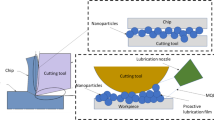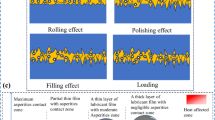Abstract
This paper investigates the impact of palm oil methyl ester (POME) and graphite nanoflakes as additives on the thermophysical and tribological properties of naphthenic and groundnut oil blends. Different ratios of the two oil blends containing the selected additives were formulated and tested. The results show that both POME and graphite nanoflakes could be potential friction modifiers. Notably, the four-ball tribometer test reveals that the addition of 7 vol% of POME to naphthenic oil and 0.01 wt% graphite nanoflakes to naphthenic oil results in the reduction of wear scar diameter by 24% and 59%, respectively. Surface micrographs of aluminum workpiece subjected to simple turning operation in a CNC machine corroborated the wear test results. POME in naphthenic oil resulted in better surface finish relative to POME-formulated groundnut oil. The experimental data were analyzed using artificial neural network (ANN) to gain a better understanding of the entire work. The sensitivity analysis developed from the chosen ANN models exhibited the nature of influence of the input parameters (groundnut concentrations, POME, and naphthenic oil) on the outputs (Noack volatility, thermal conductivity, and wear).















Similar content being viewed by others
References
Rizvi, S.Q.A. 2009 Comeprehensive review of lubricant chemistry, technology, selection, and design. : ASTM International.
Groover, M.P., Fundamentals of modern manufacturing: materials, processes, and systems. Fourth Edition ed. 2010, United States of America John Wiley & Sons, Inc.
Richard, G.B. and L.B. William 2005 Metalworking fluids. In: Synthetics, mineral oils, and bio-based lubricants. CRC.
Brinksmeier E, Meyer D, Huesmann-Cordes AG, Herrmann C (2015) Metalworking fluids—mechanisms and performance. CIRP Ann Manuf Technol 64(2):605–628
Lawal SA, Choudhury IA, Nukman Y (2012) Application of vegetable oil-based metalworking fluids in machining ferrous metals—a review. Int J Mach Tools Manuf 52(1):1–12
Lawal, S.A., et al. 2007 Performance evaluation of cutting fluids developed from fixed oils. Leonardo Electronic Journal of Practices and Technologies
Ojolo SJ, Amuda MOH, Ogunmola OY, Ononiwu CU (2008) Experimental determination of the effect of some straight biological oils on cutting force during cylindrical turning. Matéria (Rio de Janeiro) 13:650–663
Masjuki HH, Maleque MA (1996) The effect of palm oil diesel fuel contaminated lubricant on sliding wear of cast irons against mild steel. Wear 198(1):293–299
Dayou S, Liew WYH, Ismail MAB, Dayou J (2011) Evaluation of palm oil methyl ester as lubricant additive using milling and four-ball tests. International Journal of Mechanical and Materials Engineering 6(3):374–379
Mansot JL, Bercion Y, Romana L, Martin JM (2008) Nanolubrication. Braz J Phys 39:186–197
Berman D, Erdemir A, Sumant AV (2014) Graphene: a new emerging lubricant. Mater Today 17(1):31–42
Pop E, Varshney V, Roy AK (2012) Thermal properties of graphene: fundamentals and applications. MRS Bull 37(12):1273–1281
Balandin AA, Ghosh S, Bao W, Calizo I, Teweldebrhan D, Miao F, Lau CN (2008) Superior thermal conductivity of single-layer graphene. Nano Lett 8(3):902–907
Lin J, Wang L, Chen G (2011) Modification of graphene platelets and their tribological properties as a lubricant additive. Tribol Lett 41(1):209–215
Vincenzo D’Agostino, Adolfo Senatore, Vincenzo Petrone, Paolo Ciambelli, Maria Sarno 2012 Tribological behaviour of graphene nanosheets as lubricant additive. In 15th International Conference on Experimental Mechanics. : Porto/Portugal. pp. 22–27.
Rashmi W, Khalid M, Lim XY, Guepta TCSM, Arwin GZ (2017) Tribological studies on graphene/TMP based nanolubricant. J En Sci Technol 12(2):365–373
Selvam MD, Sivaram NM (2018) A comparative study on the surface finish achieved during turning operation of AISI 4340 steel in flooded, near-dry and dry conditions. Aust J Mech Eng:1–10
Datta S (2016) Materials design using computational intelligence techniques. CRC, Boca Raton
Selvam MD, Senthil P, Sivaram NM (2017) Parametric optimisation for surface roughness of AISI 4340 steel during turning under near dry machining condition. Int J Mach Mach Mater 19(6):554
PerkinElmer 2011 The TGA Noack test for the assessment of engine oil volatility. In Application note—thermal analysis : United States
Osama M, Walvekar R, Khalid M, Rasheed AK, Wong WY, Gupta TCSM (2018) Physical properties optimization of POME-groundnut-naphthenic based graphene nanolubricant using response surface methodology. J Clean Prod 193:277–289
Olden JD, Joy MK, Death RG (2004) An accurate comparison of methods for quantifying variable importance in artificial neural networks using simulated data. Ecol Model 178(3):389–397
Schuchardt U, Sercheli R, Vargas RM (1998) Transesterification of vegetable oils: a review. J Braz Chem Soc 9:199–210
Lee K, Hwang Y, Cheong S, Kwon L, Kim S, Lee J (2009) Performance evaluation of nano-lubricants of fullerene nanoparticles in refrigeration mineral oil. Curr Appl Phys 9(2, Supplement):e128–e131
Rashmi W, Ismail AF, Sopyan I, Jameel AT, Yusof F, Khalid M, Mubarak NM (2011) Stability and thermal conductivity enhancement of carbon nanotube nanofluid using gum arabic. J Exp Nanosci 6(6):567–579
Rasheed AK, Khalid M, Rashmi W, Gupta TCSM, Chan A (2016) Graphene based nanofluids and nanolubricants—review of recent developments. Renew Sust Energ Rev 63:346–362
Ghadimi A, Saidur R, Metselaar HSC (2011) A review of nanofluid stability properties and characterization in stationary conditions. Int J Heat Mass Transf 54(17–18):4051–4068
Stachowiak, G.W. and A.W. Batchelor, Chapter 2. Physical properties of lubricants, in engineering tribology (third edition). In: G.W.S.W. Batchelor, Editor. 2006, Butterworth-Heinemann: Burlington. pp. 11–50.
Rasheed AK, Khalid M, Walvekar R, Gupta TCS, Chan A (2016) Study of graphene nanolubricant using thermogravimetric analysis. J Mater Res 31(13):1939–1946
Adhvaryu A, Erhan SZ, Liu ZS, Perez JM (2000) Oxidation kinetic studies of oils derived from unmodified and genetically modified vegetables using pressurized differential scanning calorimetry and nuclear magnetic resonance spectroscopy. Thermochim Acta 364(1–2):87–97
Sharma BK, Adhvaryu A, Perez JM, Erhan SZ (2008) Effects of hydroprocessing on structure and properties of base oils using NMR. Fuel Process Technol 89(10):984–991
Alves SM, Barros BS, Trajano MF, Ribeiro KSB, Moura E (2013) Tribological behavior of vegetable oil-based lubricants with nanoparticles of oxides in boundary lubrication conditions. Tribol Int 65:28–36
Williamson, B.P. and J.C. Bell 1996 The effects of engine oil rheology on the oil film thickness and wear between a Cam and Rocker follower. SAE International.
Fernández-Abia AI, Barreiro J, Lacalle LNL, Martínez S (2011) Effect of very high cutting speeds on shearing, cutting forces and roughness in dry turning of austenitic stainless steels. Int J Adv Manuf Technol 57(1):61–71
Acknowledgments
We acknowledge the ExcelVite Sdn. Bhd. and the Nynas Pte. Ltd. for supplying the POME and naphthenic base oils, respectively.
Author information
Authors and Affiliations
Corresponding author
Ethics declarations
Conflict of interest
The authors declare that they have no conflict of interest.
Additional information
Publisher’s note
Springer Nature remains neutral with regard to jurisdictional claims in published maps and institutional affiliations.
Rights and permissions
About this article
Cite this article
Rashmi, W., Osama, M., Khalid, M. et al. Tribological performance of nanographite-based metalworking fluid and parametric investigation using artificial neural network. Int J Adv Manuf Technol 104, 359–374 (2019). https://doi.org/10.1007/s00170-019-03701-6
Received:
Accepted:
Published:
Issue Date:
DOI: https://doi.org/10.1007/s00170-019-03701-6




